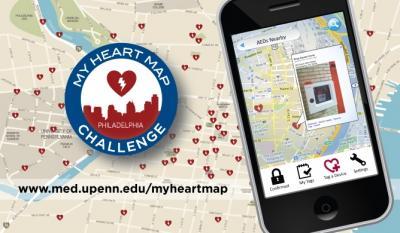LOS ANGELES – A crowdsourcing contest that sent hundreds of Philadelphians to locate and catalog the locations of AEDs throughout the nation's fifth largest city led to the identification of more than 1,400 automated external defibrillators in public places, according to a study from researchers from the Perelman School of Medicine at the University of Pennsylvania that will be presented today at the American Heart Association's Scientific Sessions 2012 (Abstract #17478). The efforts of these "citizen scientists" are expected to help provide crucial data to ensure quick bystander response to out-of-hospital cardiac arrests, which is among the nation's leading killers.
Participants in the MyHeartMap Challenge, conducted over eight weeks during the winter of 2012, used a custom smart phone app to photograph AEDs, catalog their GPS coordinates, and enter information about other details such as the device's location in the building. Unlike implantable medical devices, AEDs are not subject to Food and Drug Administration regulations that require their manufacturers to track where they're placed after purchase, so the estimated 1 million devices across the United States often go unused during cardiac arrests, when prompt defibrillation is essential to improving the odds of surviving. The MyHeartMap Challenge findings provide essential data for the Penn Medicine team's efforts to build an AED map that will be accessible both by Philadelphia's 911 operators and by members of the public, who will be able to locate AED locations via a mobile app during cardiac emergencies.
More than 300 individuals and teams participated in the contest, locating 1,429 AEDs in more than 525 buildings across the city. The devices were most commonly found within gyms (19 percent), schools (16 percent), and offices (11 percent). Two winners, who each identified more than 400 AEDs, each received a $9,000 prize.
"Finding AEDs during this contest was a very hard task – many AEDs, we found, are in places people wouldn't think to look during an emergency, or were hard to obtain without special permission from building managers or security personnel," said MyHeartMap Challenge director Raina Merchant, MD, MSHP, an assistant professor of Emergency Medicine and a senior fellow in Penn's Leonard Davis Institute of Health Economics. "But we're so impressed with the creative ways people sought out devices and provided us with information that we'll now be able to use to ensure that these devices are in the right place to save lives."

Penn Medicine's MyHeartMap Challenge, a crowdsourcing contest that sent hundreds of Philadelphians to locate and catalog the locations of AEDs throughout the nation's fifth largest city led to the identification of more than 1,400 automated external defibrillators in public places.
(Photo Credit: Penn Medicine)
A separate study that Merchant will present at the Scientific Sessions provides additional clues about gaps in AED coverage in the community (Abstract #15). Of 1,420 buildings canvassed by her team in 2011 prior to the MyHeartMap Challenge, 88 percent did not have AEDs. In those that did, security and liability concerns were frequently cited as reasons for not allowing access to the device, and the time it took to obtain information and permission to use the device took valuable time – as long as 55 minutes, with a mean time of four minutes. Only 4 percent of AEDs found during that search had been used.
A third Penn Medicine study (Abstract #199), modeled after a recent European investigation, reveals that public education also remains a key priority for improving use of AEDs. The researchers surveyed 222 adults in two public transportation stations about their knowledge of AEDs, who is permitted to use them, and their willingness to utilize the devices in an emergency. Twenty five percent of respondents reported having been trained in CPR during the past five years, and 63 percent said they would call for help and/or dial 911 if they witnessed a cardiac arrest scenario. But only 8 percent of those surveyed spontaneously suggested using an AED when asked what other actions they would take. Fifty-nine percent of respondents were aware that AEDs are available in public places, but only 38 percent were aware the devices can be used by lay people – many reported they believe they were for use only by trained medical personnel. When informed that the devices can easily be used by the lay public, only 60 percent of respondents said they would be willing to use an AED themselves during an emergency.
"Our findings reveal significant knowledge gaps about the ease of use and lifesaving potential of AEDs," said the study's senior author, Benjamin Abella, MD, MPhil, an assistant professor of Emergency Medicine and director of clinical research in Penn Medicine's Center for Resuscitation Science. "Despite much greater availability of AEDs in public places in U.S. cities today, we must continue our efforts to educate the public about AED availability, and empower people to use these devices to save lives."